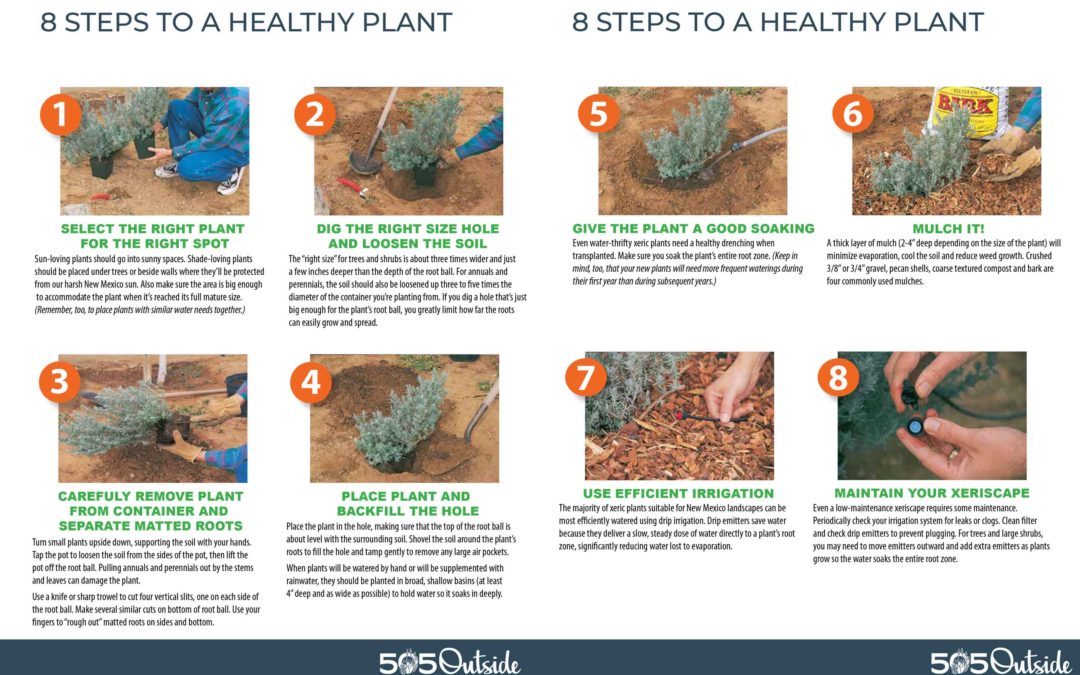With spring fast approaching and many homeowners heading out to local plant nurseries, we want to remind you how to plant for a healthy plant. Choosing the right plant for the right place is the most important consideration. Once you’ve selected the perfect desert-friendly plant, installing and irrigating it correctly are the next steps for success.
Step 1: Select the Right Plant for the Right Spot
Sun-loving plants should be planted in sunny spaces. Shade-loving plants should be placed under trees or next to walls where they’ll be protected from our intense New Mexico sun. Be sure the area is big enough to accommodate the plant when it reaches its full mature size, and remember to place plants with similar water needs together.
Step 2: Dig the Right Size Hole and Loosen the Soil
The right size hole for trees and shrubs is about three times wider and just a few inches deeper than the depth of the root ball. When transplanting annuals and perennials, look at the diameter of the plant’s container and make sure the soil around the hole is loosened up three to five times the size of the diameter of the container. If you dig a hole that’s just big enough for the plant’s root ball, you greatly limit how far the roots can easily grow and spread.
Step 3: Carefully Remove the Plant from its Container and Separate Matted Roots
Turn small plants upside down, supporting the soil with your hands. Tap the sides of the pot to loosen the soil, then lift the pot off the root ball. Pulling annuals and perennials out by their stems and leaves can cause damage.
Step 4: Place the Plant in the Hole and Backfill the Hole
Place the plant in the hole, making sure that the top of the root ball is close to level with the surrounding soil. Shovel the soil around the plant’s roots to fill in the hole and tamp gently to remove any large air pockets. If plants are going to be watered by hand or supplemented with rainwater, they should be planted in broad, shallow basins at least 4” deep and as wide as possible to hold water so it soaks deeply into the soil.
Step 5: Give the Plant a Good Soaking
Even water-thrifty xeric plants need a healthy drenching when transplanted. Make sure you soak the plant’s entire root zone. Keep in mind that your new plants will need more frequent watering during their first year than in subsequent years.
Step 6: Add Mulch!
A thick layer of shredded wood chip mulch, 2”- 4” deep depending on the size of the plant, will minimize evaporation, cool the soil and reduce weed growth.
Step 7: Use Efficient Irrigation
The majority of desert-friendly plants suitable for New Mexico landscapes can be most efficiently watered using drip irrigation. Drip emitters save water because they deliver a slow, steady dose of water directly to the plant’s root zone, significantly reducing evaporation.
Step 8: Maintain Your Desert-Friendly Xeriscape
Even a low-maintenance xeriscape requires some maintenance. Periodically check your irrigation system for leaks or clogs. Clean the filter and check drip emitters to prevent plugging. For trees and large shrubs, you may need to move emitters outward and add extra emitters as plants grow to make sure water soaks the entire root zone. Use our Water by the Seasons Watering Recommendations for all your seasonal water needs.
Check out our free .pdf, display it in a visible place and use it when you start your spring plantings.

Learn more by checking out these other useful drip irrigation articles:
Watering to Establish New Plantings


